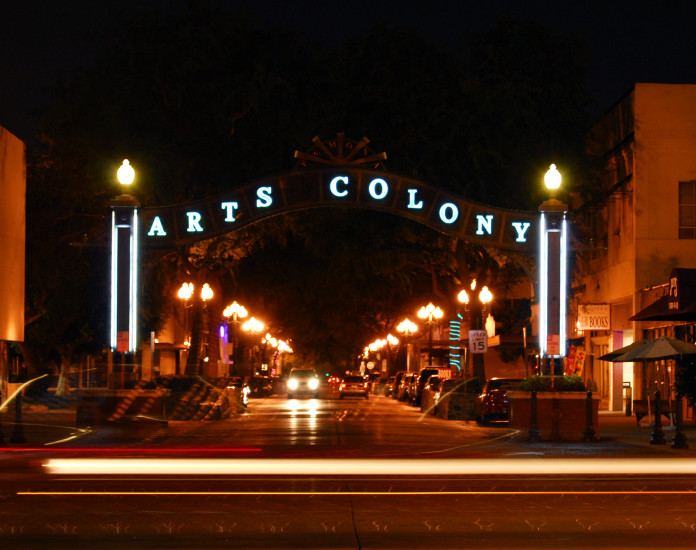
As a three year house party implodes, the question of art as redevelopment still stands
By Mark Cromer
Watts is not burning again, but a lot of money has apparently gone up in smoke and good will has withered on the vine into a bitter vintage as the Watts House Project has bogged down into a series of delays and snafus that may prove to be the end of it.
Heralded as a visionary approach to refurbishing the residential homes around the iconic Watts Towers, the project launched by artist Edgar Arceneaux was to pair artists and architects and then partner them with the individual homeowners in a collaborative effort rehabilitate the structures and revitalize the neighborhood.
Riding high on plumes of lofty egalitarian pronouncements (declarations so sweepingly optimistic that they may have been emanating at least partially from a more tangible, organic source material…), the non-profit group Arceneaux established to direct the project was able to land funding from some art world heavyweights.
The Andy Warhol Foundation, LACMA, and ArtPlace were among those that seeded around $700,000 into what was imagined in 2009 as an effort that would grow organically and become a model for how art can tangibly reinvigorate economically depressed neighborhoods.
Armed with money, vision and talent, what could go wrong? Apparently everything.
In a lengthy feature expose published in the Los Angeles Times in April, reporter Jori Finkel deconstructed the project as ultimately a series of well-intended mishaps that dragged on, eventually leaving residents in the neighborhood it was supposed to benefit estranged and at least one artist accusing the project of using his art without permission.
Arceneaux resigned as the project’s director the day after Finkel’s article hit the newsstands and the organization seems to be attempting to reboot and regain some momentum.
Yet whatever its eventual fate, the Watts House Project raises fundamental questions about using art as the cornerstone in redevelopment efforts; particularly in communities and neighborhoods that struggle with chronic and severe economic issues. Are such altruistic endeavors really about helping the residents in these neighborhoods, or are they more about the people who dream them up?
Elizabeth Currid-Halkett, author of The Warhol Economy: How Fashion, Art & Music Drive NYC and professor at USC’s Price School of Public Policy, says that art has long had a role in helping distressed communities and neighborhoods recover.
“Historically art has been very instrumental in revitalizing depressed communities,” Currid-Halkett says. “But the issue tends to be how art was used to achieve those results, how it came into play. And that’s not always with a specific plan.”
Perhaps the most prominent such case of art acting as the rudder in a turnabout of a neighborhood was late 1960s and early 1970s SoHo, much of classic but abandoned industrial buildings were slated for demolition in a plan—embraced by popular New York City Mayor John Lindsey—to make way for an expressway.
“You look at SoHo during this period, and you had all these abandoned manufacturing buildings which were going to be torn down, but artists had been moving into them and setting up their studios,” Currid-Halkett says. “Eventually that was followed by the galleries and working studios and then ultimately gentrification sets in.”
The SoHo example, as it were, was something of an accidental revitalization, a confluence of artists (some of them illegal squatters) being drawn to the majestic grit of urban-industrial spaces and being able to harness them in pursuit of their own craft and trade. A growing preservationist movement in New York City that was fueled by a rage over the demolition of the original Penn Station just a few years earlier also played a role in SoHo’s turnaround.
In Southern California, the Pomona Arts Colony stands as an ongoing effort to breathe new life into what had been the first outdoor commercial mall of its size west of the Mississippi, which by the mid to late 1970s had fallen into a decay that blighted much of the city. Though it is has struggled at times, the arts colony (paired with an antique row) has grown to nearly 40 art venues and is now known for its artist lofts and work-live spaces.
Like SoHo, Pomona’s downtown colony benefits from classic commercial and industrial architecture that unfolds from another era, embraced by artists and protected by preservationists.
Artist Kathryn Anne Miller, a professor of art with an emphasis of environmental studies at Pitzer College, sees a cycle come into play in places like Culver City and Pomona. “Artists tend to go into areas that are least desirable and proceed to make them desirable over time,” she says. “Then eventually, the neighborhoods get so desirable the artists that invigorated them get priced out, along with most everyone else.”
Miller says that Compton is now undergoing the early stages of this sort of renewal by the flow of an artistic tide.
As for neighboring Watts, Currid-Halkett says the idealism that may have been behind the Watts House Project was never going to be much of a solution to entrenched social ills that neighborhood blight reflects.
“Art as beautification in depressed communities is a Band-Aid,” she says. “But artistic communities that spring up tend to bring other development that’s beneficial to the community and that’s the more prudent effective approach.”
This article was first published in Artillery magazine.










